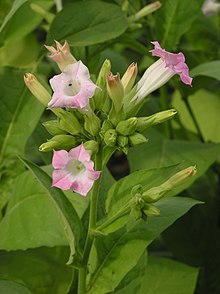Nicotiana tabacum
| Nicotiana tabacum | |
|---|---|
 |
|
| Scientific classification | |
| Kingdom: | Plantae |
| (unranked): | Angiosperms |
| (unranked): | Eudicots |
| (unranked): | Asterids |
| Order: | Solanales |
| Family: | Solanaceae |
| Genus: | Nicotiana |
| Species: | N. tabacum |
| Binomial name | |
|
Nicotiana tabacum L. |
|
Nicotiana tabacum, or cultivated tobacco, is an annually-grown herbaceous plant. It is found only in cultivation, where it is the most commonly grown of all plants in the Nicotiana genus, and its leaves are commercially grown in many countries to be processed into tobacco. It grows to heights between 1 and 2 meters. Research is ongoing into its ancestry among wild Nicotiana species, but it is believed to be a hybrid of Nicotiana sylvestris, Nicotiana tomentosiformis, and possibly Nicotiana otophora.
In their great first voyage to the New World, Christopher Columbus and his expedition were introduced to a plant whose smoke was called tobacco by the natives of Hispaniola. In 1560, Jean Nicot de Villemain brought tobacco seeds and leaves as a "wonder drug" to the French court. In 1586 the botanist Jaques Dalechamps gave the plant the name of Herba nicotiana, which was also adopted by Linné. It was considered a decorative plant at first, then a panacea, before it became a common snuff and tobacco plant. Tobacco arrived in Africa at the beginning of the 17th century. The leaf extract was a popular pest control method up to the beginning of the 20th century. In 1851, the Belgian chemist Jean Stas documented the use of tobacco extract as a murder poison. The Belgian count Hippolyte Visart de Bocarmé had poisoned his brother-in-law with tobacco leaf extract in order to acquire some urgently needed money. This was the first exact proof of alkaloids in forensic medicine.
...
Wikipedia
